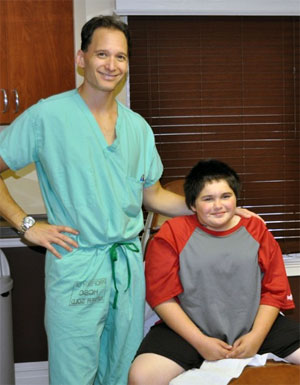
12-Year-Old Fairbanks, Alaska Boy Finally Breathes Easier After Phrenic Nerve Surgery
October 22, 2012
For Kaufman, reconstructive plastic specialist and the only known surgeon to perform phrenic nerve surgery, young Tristan represented roughly the 65th such surgery since undertaking this procedure in 2007. The phrenic nerve controls function of the diaphragm muscle – the primary muscle involved in breathing. Contraction of the diaphragm muscle permits expansion of the chest cavity and inhalation of air into the lungs. In Tristan’s case, the paralysis had caused the right side of his diaphragm to essentially be pushed up to the top of his chest, preventing the lung from expanding with inspiration of breath. The long medical saga for Tristan and his family began four years ago, when the avid football player had trouble breathing. As is often the case with Dr. Kaufman’s patients, initially asthma was automatically diagnosed. When the problem did not resolve, it was determined Tristan had Klippel-Feil Syndrome, a devastating disease characterized by fusion of any of the cervical vertebrae, potentially causing severe damage to major organs. Tristan was banned from all contact sports—primarily his beloved football– due to two missing discs in his neck. Tristan, with a medical school student’s grasp, describes his ordeal. “Klippel-Feil affects one in 42,000 kids. Doctors went through an MRI looking for bone cancer or scoliosis.” The trips to doctors led Tristan to ask his mother, “Am I going to die?” It turned out however, that aside from the missing cervical discs, Tristan’s only remaining problem was the diaphragm paralysis caused by his paralyzed phrenic nerve. After four years of desperation at a variety of doctors as far from their home as Seattle, the family ultimately heard the same line that has become universal with Dr. Kaufman’s phrenic nerve patients. “You’re just going to have to live with it.” That wasn’t good enough for Tristan’s mom, Tracy Loitz, and his dad Roger. In April 2012, Tracy went on the Internet and found Dr. Kaufman. In October, Tristan, his mom and dad and 8-year-old sister Hanna spent a month in New Jersey for his procedure, including homework done on the road and sightseeing in New York City. According to Dr. Kaufman, who sees a relationship between Tristan’s case of Klippel-Feil Syndrome and his phrenic nerve damage, the fused cervical vertebrae were associated with abnormal development and function of the phrenic nerve in the neck, ultimately predisposing it to injury. A week after surgery, the family was ready to return home. Tristan awaits respiratory therapy, and beginning to exercise and lose weight from being forced to be sedentary. Remarkably, his father, who had often watched Tristan breathe during sleep, was able for the first time following the surgery to see the right side of his son’s chest rise and fall as his son slept. As is customary in this surgery, the full result evolves over about a year’s time, with healing of the phrenic nerve and strengthening of the diaphragm muscle. That will happen when Tristan now takes his place in gym class or on the soccer field or basketball court. “Emotionally, I felt broken-hearted not being able to run with my friends,” he says. “Now, I feel great. Hopefully, I can run with my friends longer.” And his father says, “I look forward to watching him run without the blue-green tinge I’d see on his neck due to lack of oxygen.” Tracy, who used to feel sick going to the doctors with her son, and was devastated after every diagnosis, immediately felt entirely different with Dr. Kaufman and the staff at The Institute for Advanced Reconstruction. “We’ve had the most wonderful experience, and from the beginning, I felt the utmost confidence. Everyone has been so comforting. To have an answer is very calming. And this proved there is always a possibility to make things better.” When told during his post-surgical exam with Dr. Kaufman that the scar from his surgery would ultimately heal, Tristan, his comic skills honed over years of dealing with medical crisis, responded tongue in cheek, “I don’t want it to fade; it’s manly.” Patients have come from around the U.S. and as far away as Australia to be operated on by Dr. Matthew Kaufman for phrenic nerve injuries. They have ranged in age from 11 to the early 70s with a success rate of 70% to 80%.
Source of News:
E-mail your news &
photos to editor@sitnews.us
|
|||
